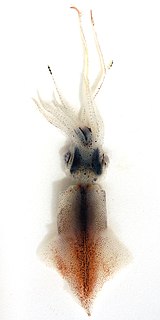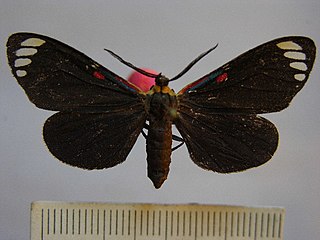Related Research Articles
Henry Vaughan was a Welsh metaphysical poet, author, translator and physician, writing in English. He is chiefly known for religious poetry published in Silex Scintillans in 1650, with a second part in 1655. In 1646 his poems, with the Tenth Satyre of Juvenal Englished, were published, followed by a second volume in 1647. Meanwhile, he had been persuaded by reading the religious poet George Herbert to give up "idle verse". The prose Mount of Olives or Solitary Devotions (1652) shows the depth of his religious convictions and authenticity of his genius. Two more volumes of secular verse followed, ostensibly without his sanction, but it is his religious verse that has been acclaimed. He also translated short moral and religious works and two medical works in prose. In the 1650s he began a lifelong practise in medicine.

Stomiiformes is an order of deep-sea ray-finned fishes of very diverse morphology. It includes, for example, dragonfishes, lightfishes, loosejaws, marine hatchetfishes and viperfishes. The order contains 4 families with more than 50 genera and at least 410 species. As usual for deep-sea fishes, there are few common names for species of the order, but the Stomiiformes as a whole are often called dragonfishes and allies or simply stomiiforms.

Noctiluca scintillans, commonly known as the sea sparkle, and also published as Noctiluca miliaris, is a free-living, marine-dwelling species of dinoflagellate that exhibits bioluminescence when disturbed. Its bioluminescence is produced throughout the cytoplasm of this single-celled protist, by a luciferin-luciferase reaction in thousands of spherically shaped organelles, called scintillons.

Milky seas, also called mareel, is a luminous phenomenon in the ocean in which large areas of seawater appear to glow translucently. The phenomenon glow brightly enough at night to be seen by satellites orbiting Earth.

The firefly squid, also commonly known as the sparkling enope squid or hotaru-ika in Japan, is a species of squid in the family Enoploteuthidae. It is the sole species in the monotypic genus Watasenia. These tiny squid are found on the shores of Japan in springtime during spawning season, but spend most of their life in deeper waters between 200 and 400 metres. They are bioluminescent organisms and emit blue light from photophores, which some scientists have hypothesized could be used for communication, camouflage, or attracting food, but it is still unclear in the scientific community exactly how this species uses their bioluminescence. The firefly squid is a predator and actively hunts its food, which includes copepods, small fish, and other squids. The lifespan of a firefly squid is about one year. At the end of their lives females return close to shore to release their eggs, then die shortly thereafter. This mass migration of firefly squid to the shore is a lucrative business for Japanese fishermen, and during spawning season many go out to the bays to collect the dying squid. Many more also visit Japan during spawning season to see the bright blue light created from the firefly squid's bioluminescence light up the bay, making their spawning season not only a fishing opportunity but also a tourist attraction.

The copper pheasant or Soemmerring's pheasant is endemic to Japan. The scientific name commemorates the German scientist Samuel Thomas von Sömmerring.

Cosmosoma is a genus of tiger moths in the subfamily Arctiinae. The genus was erected by Jacob Hübner in 1823.

Cyanopepla is a genus of moths in the subfamily Arctiinae. The genus was erected by James Brackenridge Clemens in 1861.
Eressa is a genus of moths in the family Erebidae. The genus was erected by Francis Walker in 1854.
Lysceia is a monotypic moth genus in the subfamily Arctiinae described by Francis Walker in 1854. It contains a single species, Lysceia bigutta, described by the same author in the same book, which is found in South Africa.

Melese is a genus of moths in the family Erebidae. The genus was erected by Francis Walker in 1854.

Phaloesia is a monotypic of tiger moth genus in the family Erebidae. Its only species is Phaloesia saucia, the saucy beauty moth. The genus and species were first described by Francis Walker in 1854. It is found from the lower Rio Grande Valley of Texas in the United States to Venezuela.

Parotis is a genus of moths of the family Crambidae.

Somena is a genus of tussock moths in the family Erebidae. The genus was erected by Francis Walker in 1856.

Asota is a genus of moths in the family Erebidae first described by Jacob Hübner in 1819. Species are widely distributed throughout Africa, India, Sri Lanka, Myanmar, the Malayan region and tropical parts of the Australian region.

Somena scintillans, the yellow tail tussock moth, is a moth in the family Erebidae described by Francis Walker in 1856. It is found in northern India, Sri Lanka, Myanmar and the Andaman Islands. Though considered a minor pest, larva can sporadically be a serious pest.
Chalcosia venosa is a moth in the family Zygaenidae. It was described by Francis Walker in 1854 from Sri Lanka.
Procotes is a monotypic moth genus in the Zygaenidae family described by Arthur Gardiner Butler in 1876. Its single species, Procotes diminuta, described by Francis Walker in 1854, is found in Sri Lanka.
Thyrassia subcordata is a moth in the family Zygaenidae. It was described by Francis Walker in 1854 from Sri Lanka. One subspecies is recorded, Thyrassia subcordata aurodiscaHampson, 1891.
Trypanophora trapobanes is a moth in the Zygaenidae family. It was described by Francis Walker in 1854 from Sri Lanka. Its larval host plants are in the genus Lagerstroemia.
References
- ↑ "Heteropan scintillans Walker, 1854". Insecta.pro. Insects catalog. Retrieved 24 December 2017.
- ↑ "Species Details: Heteropan scintillans Walker, 1854". Catalogue of Life. 20 December 2017. Retrieved 24 December 2017.
- ↑ Savela, Markku. "Heteropan scintillans Walker, 1854". Lepidoptera and Some Other Life Forms. Retrieved 24 December 2017.
| This article on a moth of the family Zygaenidae is a stub. You can help Wikipedia by expanding it. |